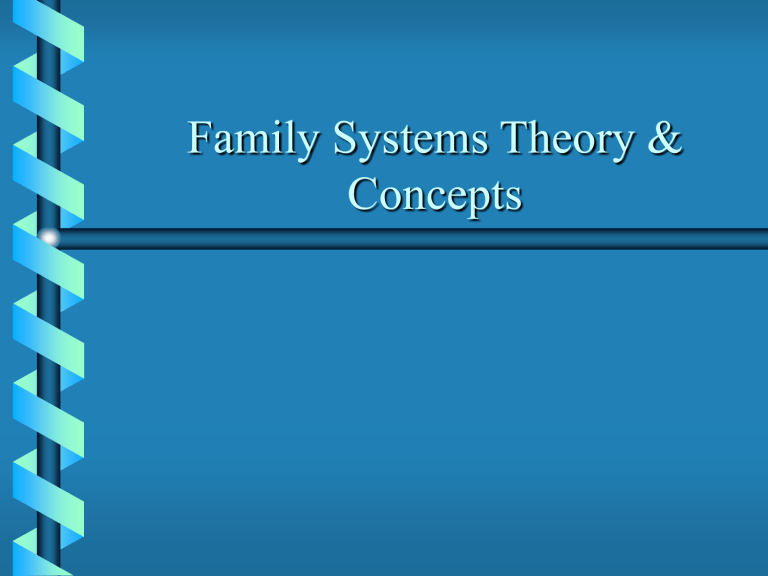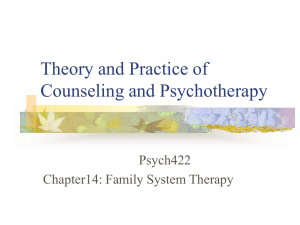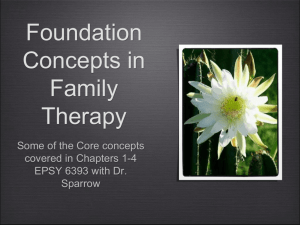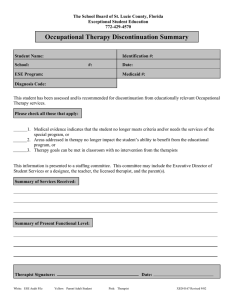Family Systems Theory & Concepts

Family Systems Theory &
Concepts
Some Major Family Therapy
Approaches
———— - Behavioral
Virginia Satir - Communication
Ivan Boszormenyi-Nagy - Contextual
Salvador Minuchin - Structural
Jay Haley - Strategic
David & Jill Scharff - Object Relations
Murray Bowen - Multigenerational
Past
or Present ? An Important
Distinction in FT Approaches
Two basic approaches:
•
Ahistorical - Communication, Strategic,
Structural, Behavioral
• Historical - Object Relations,
Multigenerational (Bowenian)
Behavioral Approach
Is ahistorical & is concerned with how, when, where,
& what rather than why. Reward/punishment norm.
Guided by "the basic belief that behavior is determined more by its consequences than by its antecedents."
(Dorothy & Raphael Becvar, Family Therapy: A System Integration, 2 nd
ed., Boston: Allyn & Bacon, 1993, 257)
Focus is upon having the couple/family members increase the frequency of positive behavior.
See Richard Stuart, Helping Couples Change, NY: Guilford, 1980)
Communications Approach
Focuses upon “the redundant patterns of communication and interaction within and between systems.”
(Becvar & Becvar, Family Therapy , 211)
Clear, congruent messages are necessary for healthy family relationships.
Incongruent communication styles/stances include: placating, blaming, super-reasonable, & irrelevant or distracting.
Contextual Family Therapy
Transgenerational, psychoanalytical approach that focuses upon fairness in family relationships, equitability, trustworthiness, & loyalty. Seeks to uncover & resolve family "obligations" and "debts" incurred over time. Discusses "loyalty" and
"legacy;" thrust is to establish or restore trustworthiness in family relationships. Therapist does not take a prescriptive, restructuring role, nor a reframing one; instead, elicits family members' thinking about the other persons' perspectives as well as their own.
Structural Family Therapy
Salvador Minuchin – worked with poverty-stricken, underprivileged families grappling with day-to-day survival
(Philadelphia Child Guidance Center).
Structuralism refers to the identification of codes that regulate human behavior. Identifies the regulating codes in reference to boundaries, alignment, & power.
Uses three "challenging" strategies to address the family's symptom, structure, & reality.
Therapist takes a very active and manipulative role.
Strategic or Problem-Solving
Family Therapy
Jay Haley – worked with Minuchin from 1967-76. Began
Family Therapy Institute in Washington, D.C. in 1976.
Developed a brief, problem-focused approach. Contends that
"change occurs not through insight and understanding but through the process of the family carrying out directives issued by the therapist."
(Becvar & Becvar, Family Therapy , 193)
Concerned principally with four interrelated elements: symptoms, metaphors, hierarchy, & power.
Strong emphasis on symptoms which are seen as a way of communicating metaphorically within the family. Therapist adopts an authoritative stance that is highly directive & uses very manipulative procedures.
Object Relations family Therapy
A psychoanalytic approach that focuses on the family by
"listening, responding to unconscious material, interpreting, developing insight, and working in the transference and countertransference toward understanding & growth."
"Insight occurs when we can see together that the way the family relates to the therapist reflects the transference of repressed feelings and behavior rooted in earlier experiences with the families of origin. The therapeutic relationship offers an environment similar enough to stimulate this emergence but different enough to allow reworking."
(David & Jill Scharff, Object Relations Family Therapy, NJ: Jason Aronson, 1987, 3)
Bowenian Family Theory Concepts
Murray Bowen – clinical work with schizophrenics & their families at the Menninger Clinic & NIMH. Provides theory base to bridge psychodynamic and systems approaches.
8 interlocking concepts or forces shaping family functioning include:
1) Differentiation of Self
2) Triangles
3) Nuclear Family Emotional System
4) Family Projection Process
5) Emotional Cutoff
6) Multigenerational Transmission Process
7) Sibling Positions
8) Societal Regression
Bowenian Theory
See Handout:
"Some Bowenian Family Systems Theory Concepts"








